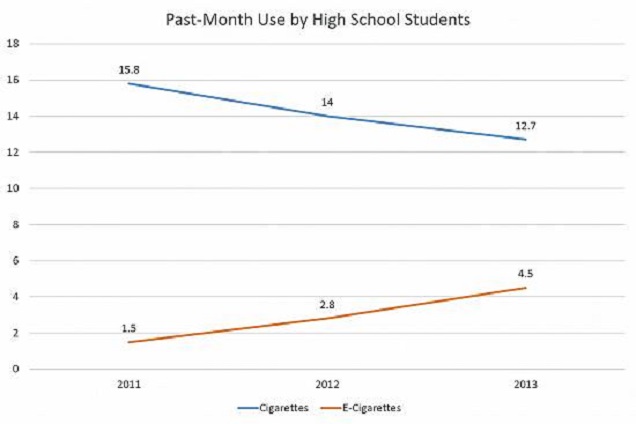 The last time the CDC’s National Youth Tobacco Survey data was released, it was accompanied with scaremongering news stories and statements like that from the CDC director, Tom Frieden, calling the rise in vaping “deeply troubling.” Now the new 2013 data has been released, while there is still some of the same sort of coverage (talking about attractive flavors, “renormalization” and the dangers of nicotine), it seems a little more muted than at the height of the panic when the last report was released. Why might that be? Well, the number of youths who’d ever vaped hasn’t changed much, and although there’s been a marked increase in “current” vaping, smoking is continuing to decline. Perhaps the figures just aren’t scary enough this time around…
The last time the CDC’s National Youth Tobacco Survey data was released, it was accompanied with scaremongering news stories and statements like that from the CDC director, Tom Frieden, calling the rise in vaping “deeply troubling.” Now the new 2013 data has been released, while there is still some of the same sort of coverage (talking about attractive flavors, “renormalization” and the dangers of nicotine), it seems a little more muted than at the height of the panic when the last report was released. Why might that be? Well, the number of youths who’d ever vaped hasn’t changed much, and although there’s been a marked increase in “current” vaping, smoking is continuing to decline. Perhaps the figures just aren’t scary enough this time around…
The National Youth Tobacco Survey: Investigating Use of Tobacco and E-Cigarettes
The National Youth Tobacco Survey is a cross-sectional, school-based, nationally-representative survey of middle school (grades 6 to 8) and high school (grades 9 to 12) students. The survey asked about a wide range of tobacco products, both combustible and non-combustible, and e-cigarettes. In the survey, current use is classed as use on any day in the past 30 days, and ever use is trying a product even once. Particularly with a new product like e-cigarettes, this methodology is bound to include some recent experimenters (who’ve vaped once in their life, just to try it out, but this happened to be in the month before the survey) in the “current” user group.
What They Found – Minor Increases in Youth Vaping
The survey found that 22.9 percent of high school students had used a tobacco product in the past 30 days, and 12.6 percent used more than one product. For middle school students, the corresponding figures were 6.5 and 2.9 percent, respectively. Of the high schoolers, 12.7 percent had smoked a cigarette over the past 30 days, and 11.9 percent had smoked a cigar, whereas smokeless tobacco was only used by 5.7 percent and snus were only used by 1.8 percent. Again, the equivalent figures for middle school students were lower, with 3.1 percent having used cigars, 2.9 percent having smoked a cigarette, and 1.4 percent having used smokeless tobacco in the past month.

For e-cigarettes, 4.5 percent of high school students had vaped in the past 30 days, and 1.1 percent of middle school students had done so. In 2012, the corresponding figures were 2.8 percent and 1.1 percent, with the new data showing no change for middle school students and an increase of around 60 percent for high school students. Ever use was 11.9 percent for high school students (compared to 10 percent in 2012) and 3 percent for middle school students (2.7 percent in 2012), again showing only minor increases. In comparison, ever-use of cigarettes was 34.7 percent for high school students and 12.7 percent for middle school students.
Rise in Vaping; Fall in Smoking
Ultimately, the rise in popularity of e-cigarettes has been accompanied by a decline in smoking. Between 2011 and 2013, the number of high school students who’d smoked a cigarette in the past 30 days decreased from 15.8 percent to 12.7 percent, while the number vaping in the past month has increased from1.5 to 4.5 percent. While this doesn’t necessarily mean that e-cigarettes are responsible for the decrease in smoking, it’s a far cry from what you’d expect to see if the fears of e-cigarettes serving as a gateway to conventional tobacco use were valid. In fact, it suggests, much like anybody with any sense has been arguing all along, that e-cigarettes are a gateway away from tobacco.

When discussing last year’s results, Tom Frieden commented, “Many teens who start with e-cigarettes may be condemned to struggling with a lifelong addiction to nicotine and conventional cigarettes.” Needless to say, the evidence has continually not supported his assertion. In fact, in this survey, they report that current use of only e-cigarettes was 0.6 percent in high school students and 0.4 percent in middle school students, and many of these could have already quit smoking by vaping or be using non-nicotine liquids. With such small numbers of never-smoking vapers, and decreasing smoking rates, the gateway hypothesis is looking more and more like complete and utter nonsense.
So There’s Nothing to Be Worried About with Youth Vaping, Right?
Well, not according to the CDC. In the discussion section, they point to the 2014 Surgeon General’s report, which apparently found that nicotine use during adolescence can adversely affect brain development, “therefore, nicotine use by youths in any form (whether combustible, smokeless, or electronic) is unsafe.”
Firstly, if you look at the actual report (PDF, on p154), you’ll notice that the only evidence for this adverse effect on brain development comes from research on rats, along with some research on adolescent smokers (which is more difficult to draw conclusions from because of potential confounding variables). Overall, the evidence seems considerably weaker than the write-up of the new youth smoking data (or the press release) would have you believe. The Surgeon General’s report calls an effect “likely,” but with only very limited human data to work with, it’s hardly compelling.
In any case, we yet again need to remember the alternative. Of course we’d all love to live in a world where teens didn’t start smoking (and thereby consuming nicotine), but that is not the world we actually live in. Sometimes young people just do things that are bad for them. However, with smoking rates decreasing as vaping rates increase and use among non-smokers been shown to be absolutely minimal time and time again, it’s clear that those youths who may have their brain development adversely affected by the nicotine in e-cigarettes would almost definitely be smokers already, or at very least would likely have smoked instead had e-cigs not been available. And, just in case it needs to be clarified, smoking is much, much worse than vaping any way you look at it.
Conclusion
E-cigarettes have always primarily appealed to current smokers, and as they continue to increase in popularity, it can be expected we’ll see more and more smokers, of whatever age, making the switch. Rises in youth vaping are to be expected, plain and simple. The real concern is for non-smoking youth starting to vape, and this has been consistently shown to be incredibly rare. Given the substantial reduction in harm expected from switching to vaping and the fact that there were nearly three times more high school aged smokers than vapers, if anything, we should be encouraging more current youth smokers to start vaping. That is, if we’re primarily interested in reducing harm to the population rather than pursuing a misguided fantasy-world in which no teens ever consume nicotine in any form.

